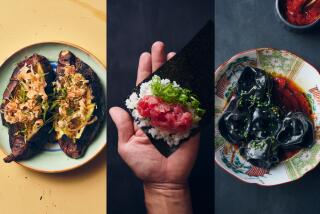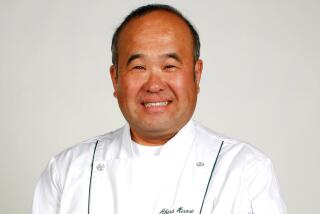Review: At Kinjiro in Little Tokyo, ride the izakaya range with a Cowboy

Thick-cut prime beef tongue at Kinjiro.
- Share via
Kinjiro, the most elegant izakaya in Little Tokyo, is in the Honda Plaza at the far end of the neighborhood, in the space most recently inhabited by the offal-intensive izakaya b.o.s., which closed last fall, and to a casual observer it may seem basically unchanged. Owner Jun Isogai still prowls the front of the house, controlling reservations and engaging his customers in long conversations on the provenance of the sake. Yoshizaku Kondo, the sous-chef at b.o.s., is behind the stove.
The lines are nowhere near as long as they can be at Sushi Gen or the excellent shabu-shabu parlor Kagaya, also in the plaza, but they don’t have to be. If you don’t have a reservation, you will most likely not be allowed past the door. Kinjiro may be relatively democratic, but it is also quite small. You are not the only one with wasabi-flavored potato salad on his mind.
The concept of an izakaya is simple: You get something to drink and then you get some food to go with it. You are allowed to order one course at a time. You can get two courses or a dozen. You are allowed, even encouraged, to share. An izakaya may have seemed impossibly complicated a decade or so ago, but most of the fashionable restaurants in Los Angeles have since adopted izakaya service — you’re used to booze-oriented menus and small plates now.
Counter Intelligence: Sign up for Jonathan Gold’s weekly newsletter
Kinjiro has a decent beer selection, including at least 10 options from the Japanese cult brewer Hitachino Nest, including Ancient Nipponia and the relatively hard to find XH, a Belgian-style ale ripened in old sochu casks. The sake list isn’t bad either.
But I am a peasant: I have never visited Kinjiro without ordering a bottle of Cowboy, a naturally fermented yamahai-style sake from Niigata, a red wine drinker’s sake as massively flavored as a steakhouse Cabernet Sauvignon. Not surprisingly, Cowboy is known for its affinity with beef — its label features an anatomically correct bull. The walls may have been painted and the furniture moved around in the transition to the new restaurant, but the display of Cowboy bottles so prominent at b.o.s. has not been changed a bit.
So you get your Cowboy, which comes to the table chilled. You experiment, perhaps, with the sake no sakana, salty, funky, ultra-traditional bar snacks that may include slivers of flying squid fermented in its own ink, firefly squid marinated in sweetened soy or half-rotted bonito intestines smeared on cream cheese, which is both more traditional and more delicious than it sounds. (Kondo also served the bonito guts when he cooked at the long-shuttered Izayoi, around the corner from the Kinjiro spot.) You try the nanbanzuki, a seasonal dish of smelt that is deep-fried, then pickled and served cold — when you land the right smelt, the crunch of its eggs is unexpected and delightful. You get a tiny parfait of sea urchin layered with sliced raw scallop, cooked blue crab and a luscious, citrus-tart ponzu jelly. The bottle of Cowboy has started to warm. Perhaps it is time for meat.
At Kinjiro, nasu dengaku, a popular summertime dish of halved Japanese eggplants broiled under a thick, sweet miso glaze, becomes bone marrow dengaku. The miso bubbles and caramelizes beautifully on the sawn bones. The half melted marrow, searingly hot, has a similar softness to the vegetable and carries the sweetness as beautifully but is almost infinitely rich. A spoonful or so will do, smeared onto toast.
Tourists love the dish, Isogai confides. Bone marrow is apparently still banned in Japan, but the taste for the oozy offal lingers.
The sashimi courses may include a beautiful arrangement of lightly vinegared mackerel dotted with spicy yuzo kosho paste or beautiful madai snapper from Japan, but also thinly sliced raw Japanese Wagyu beef with cherry tomato wedges and a sauce made by boiling sansho pepper with sugar and soy. You can get miso-broiled cod, but the dish on every table is thick-cut seared beef tongue served naked and unadorned. It is possible to visit the restaurant without being offered the dashi-simmered snapper head or even the seared uni, but you are unlikely to leave without being urged to try the dark, umami-intensive dish of miso-simmered tongue, sinew and tripe. In the maki-age, a chicken thigh is boned, fried and formed into a kind of roulade, precisely arranged enough that you can discern the textures and flavors of the different muscles in the meat.
As the courses become heavier and the Cowboy warms further, Isogai may pour the sake into a rough, hand-molded carafe and raise its temperature to blood heat. I had been taught that only cheap industrial sake was meant to be served hot. Apparently, I was wrong. A plate of agedashi appears, a big, fried dome of house-made tofu in a dense sauce enhanced with mushrooms. Hot Cowboy goes as well with that custardy hot tofu as it does with the meat.
At the end of an izakaya meal, it is customary to finish with rice or a noodle dish, which may be the only starch you will see all meal. And while the grilled onigiri and the chilled soba here have their fans, it is hard to imagine a better end to a meal here than the simplest ochazuke, a fist-size rice ball topped with pickled plum.
“Ochazuke is usually made with green tea,’’ says Isogai, pouring hot liquid from a clay pitcher. “We do it with dashi here. We can’t help ourselves — we’re fancy.’’
::
Kinjiro
An izakaya in Little Tokyo specializes in fancy bar food, sake and beer.
LOCATION
424 E. 2nd St., Los Angeles (in the Honda Plaza), (213) 229-8200, kinjiro-la.com
PRICES
Raw dishes, $10-$18; salads $6-$10; sautéed dishes, $8-$12; steamed dishes, $12-$15; grilled dishes $9-$15, more for A5 Wagyu beef; rice and noodle dishes, $7-$17.
DETAILS
Open 6 p.m. to 10:30 p.m. Wednesdays to Sundays. Credit cards accepted. Beer, wine and sake. Validated lot parking. Reservations highly recommended.
RECOMMENDED DISHES
Sake accompaniment trio; uni, scallop and blue crab with ponzu jelly; chilled fried smelt; marinated mackerel with yuzo kosho; agedashi; bone marrow dengaku; pickled plum ochazuke.
More to Read
Sign up for The Wild
We’ll help you find the best places to hike, bike and run, as well as the perfect silent spots for meditation and yoga.
You may occasionally receive promotional content from the Los Angeles Times.







